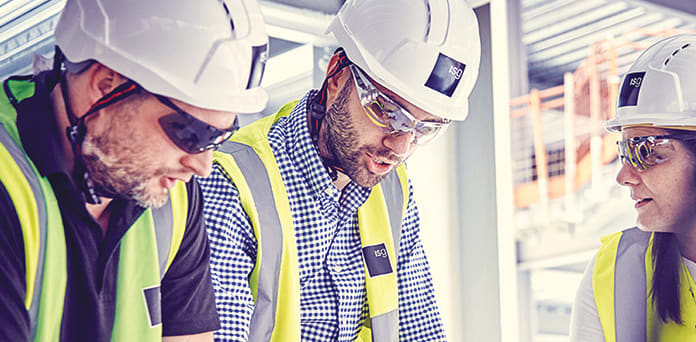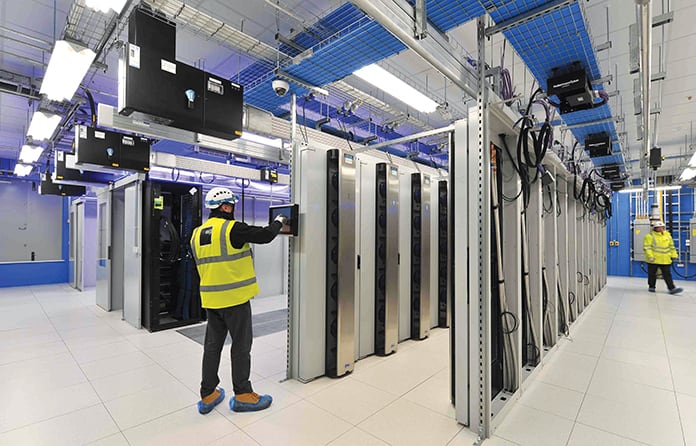ISG has set up a dedicated unit to examine how technology can improve not just its productivity, but also its approach to health and safety. Neil Gerrard finds out more.
It’s a little-known fact that bubble wrap was originally developed in 1957 as a textured wallpaper, before IBM saw its potential for a completely different purpose: protecting its delicate 1401 computer while in transit.
Sometimes a technology ends up being used for an application beyond the one for which it was originally intended, and it’s with that in mind that ISG has created a dedicated “technology incubator”, which involves members of its IT team and other key stakeholders.
The incubator team has been tasked with identifying ways in which existing technology can be turned towards improving ISG’s business practices – and it is already having a marked impact on the way in which it approaches health and safety.
One example is its use of QR codes, as health and safety director Cavan Woods explains. “They are utilised massively in retail and manufacturing but construction doesn’t seem to have identified just how flexible they are,” he says.
In recognition of its multinational workforce, and the fact that in order for workers to truly understand the health and safety hazards in their place of work they need information in their own language, ISG has started quizzing staff on some sites about their native tongue before applying a QR code to the worker’s hard hat.
If the worker’s native language is French, for example, they can then stand in front of smart screens equipped with a camera that will read the QR code and display the relevant safety information in French.
The scheme is currently being piloted on a number of ISG sites, with more set to be rolled out next year.
While the cost of translation is not cheap, a smart screen and camera is relatively inexpensive at £700-800 and worth the investment for a better educated workforce, Woods says.
And it isn’t the only application for QR codes. ISG has also applied them to all its safety information sheets on site to increase worker engagement.
“A good example would be the safety information sheets we place outside of an energised switch room,” says Woods. “They talk about the hazards and what people need to do in order to remain safe. At the bottom of the bulletin it will say ‘Do you want to know more? Scan the QR code.’”

ISG uses smart technology to communicate with its workers on site
The code will take a worker’s smartphone to a slideshow which gives them additional information on the hazards in that area. In the case of an energised switch room, that includes a millisecond-by-millisecond description as to what happens when an arc flash occurs. There’s also a link to a YouTube video showing an arc flash in real time.
“We have discovered that by imparting such in-depth information, people, especially the younger generations coming up through the industry, are very willing to engage,” says Woods.
Perhaps more futuristic still is one of the latest projects ISG is working on – using machine learning to detect if workers are wearing the correct PPE.
“It is still in the beta phase but I think we are nearly there and we are looking at a roll-out next year,” he says.
“We are looking at placing cameras at the entrances of our projects when you go into the construction area and it does a check of PPE compliance. We mandate the wearing of five-point PPE when working on our projects: hard hats, gloves, hi-vis, boots and safety glasses.
“The machine learning scans everyone who is going into the project and, if somebody is missing an item of PPE, then we have a flashing light and signal which comes up on a smart screen which says: ‘You are not prepared for work, please review your PPE’.”
Already in operation is the company’s Bluetooth beacon technology. “These tiny little Bluetooth chips can send out signals and what we have found is they are eminently programmable,” Woods says. “In conjunction with the tech incubator team, we have programmed them to send out safety signals.”
What this means in practice is that workers are invited to download an app on their phones. Bluetooth beacons, set to transmit only for a short distance are then placed around the project in so-called “safety zones”. When a worker enters that zone, they can open the app to read safety information relevant to that area, including what PPE is required, how to report hazards, where to follow designated paths, and so on.
Not only that, but ISG can use the system to send out push notifications to workers’ phones if there is an emergency such as a fire alarm going off, or if they want to update the workforce with a relevant safety bulletin.
Different construction sites can also be linked up together if required, and ISG also has the ability to geofence certain areas of a project. That means that if a worker is working on a project and is only permitted in a designated zone but tries to enter another, then ISG would get a notification, helping to enhance project security.
Given that all of this is already going on now, where does Woods see technology helping to improve worker safety in the future? He is excited about the potential of haptic technology, which allows devices to communicate with people via feel.
The aim would be to add the technology to PPE, perhaps via a vibrating silicone bracelet handed out on induction. “Then if they were to go near a hazard, we could send a signal to signify it’s a hazard,” says Woods.
Another idea, perhaps a little further off, is the type of airbag-equipped clothing now available in motorcycling and skiing, which Woods sees as a way to help prevent injury in falls from height.
“The applicability of technology is only limited by your imagination,” he says. “We are not developing products for technology’s sake. We are in the business of developing products which are going to have a tangible safety benefit for our project and for the industry.”
















